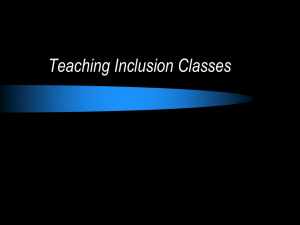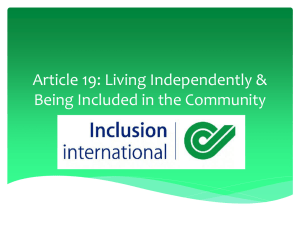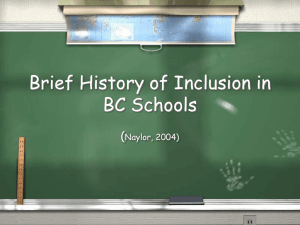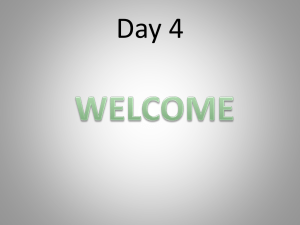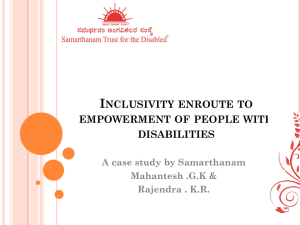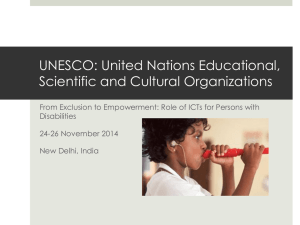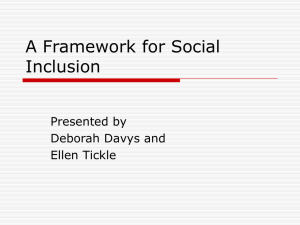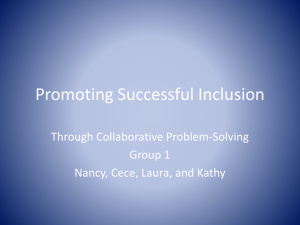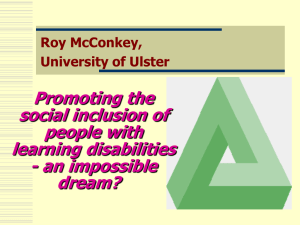Diversity & Inclusion - Michiana Chapter of SHRM
advertisement
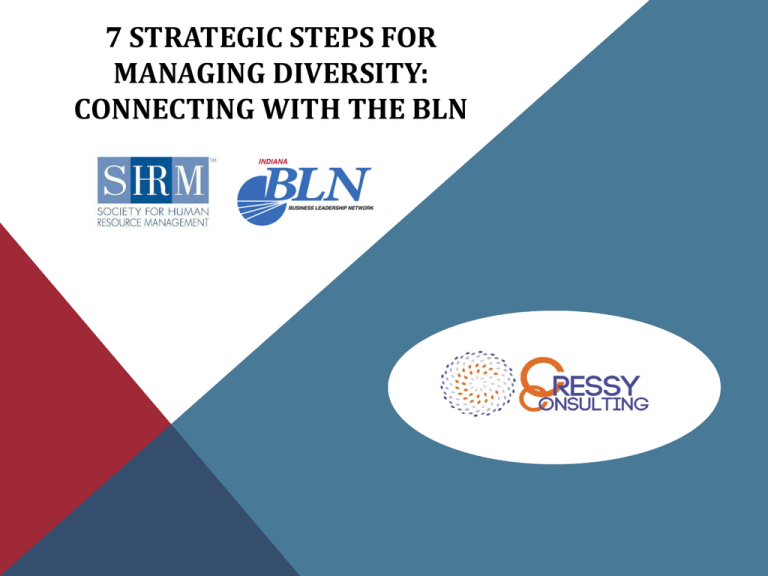
7 STRATEGIC STEPS FOR MANAGING DIVERSITY: CONNECTING WITH THE BLN THE SHRM DIVERSITY COMMITTEE Please join us! Chair: Joan Fisher - joan.fisher@mosaicinfo.org Members: Maria Stancati, Pat Tusing, Mary Jo Ogren, Erin Crawford Cressy Activities: • Meet once a month (or less) • Hosting job fair for disabled job seekers on Sept. 18 and a prejob fair workshop on Sept. 11; both held at Goodwill on Grape Rd. • Host an annual diversity luncheon speaker • Help coordinate a diversity track at the annual SHRM conference • Ideas in the works: Community-wide diversity job fair; recognition luncheon for employers engaging in ‘best practices’ for diversity and inclusion CRESSY CONSULTING The mission of Cressy Consulting is to help organizations create a culture of inclusion that validates and inspires individual and organizational success. How we achieve our mission: Training - Consulting - Coaching - Assessment Areas of expertise: Diversity & Inclusion; Women’s Leadership Development; Strategic Planning; Employee Engagement; Conflict Resolution; Wellness AGENDA • What is diversity & inclusion? • The business case for diversity and inclusion: • Demographic data • Powerful research • 7 strategic steps for managing diversity • Small group activity • Connecting with the BLN DEFINING DIVERSITY: FOUR LAYERS OF DIVERSITY THE BUSINESS CASE FOR DIVERSITY & INCLUSION: WHAT IS DIVERSITY AND INCLUSION? Inclusion: Including everyone’s voice and talents. Being open to a variety of ideas, knowledge, perspectives, approaches, and styles. Ensuring that everyone is allowed to bring their best to the workplace to maximize business success. http://www.youtube.com/watch?v=OcGBwJEHpTg THE BUSINESS CASE FOR DIVERSITY & INCLUSION The Demographics of the World are Changing: 90% of the population growth over the next 40 years is expected to come from people of color The white population will increase only 7% In 2011 almost 47% of the population in the U.S. under 18 was nonwhite More than 12% of the U.S. population is of people born outside of the United States (and more than 50% of that group has immigrated since 1990.) THE BUSINESS CASE FOR DIVERSITY & INCLUSION The Demographics of the World are Changing: In the early 1900’s more than 60% of the immigrant population was European; Today that number is below 30% and we have more immigrants from South/Central America, Africa, Asia, the Middle East, the Caribbean, etc. Thus, people look more diverse and bring with them more diverse cultural knowledge and experiences. THE BUSINESS CASE FOR DIVERSITY & INCLUSION: The Demographics of our Companies are not Changing: There are only 6 Black CEO’s (1.2%) of Fortune 500 companies Individuals identifying as Black are 13.1% of the U.S. population There are 8 Asian CEOs (1.6%) of Fortune 500 companies. Individuals identifying as Asian are 5% of the U.S. population) There are There are 6 Latino CEOs (1.2%) of Fortune 500 companies Individuals identifying as Hispanic or Latino are 16.7% of the U.S. population Women currently hold 21 (4.2 percent) of Fortune 500 CEO positions Women are 50.8% of the U.S. population THE BUSINESS CASE FOR DIVERSITY: THE BOTTOM LINE CONNECTION Fortune 500 Companies with the most women board members significantly outperform those with the least: • 53% higher Return on Equity • 42% higher Return on Sales • 66% higher Return on Invested Capital CASE STUDY In 2002, after slumping sales and realizing women were the ultimate buyers of its products, Campbell’s Soup turned to the Women of Campbell’s Network, challenging this internal company group to design a product specifically for women. The result: The Select Harvest line of soups which became a $200 million dollar business practically overnight. THE BUSINESS CASE FOR DIVERSITY & INCLUSION: THE BOTTOM LINE CONNECTION Organizations which hold diversity and inclusion as key business values experience numerous positive benefits: • Attract and retain top employees • Harness a diversity of ideas to drive innovation • Reflect the growing diversity of consumers, suppliers and business partners nationally and globally • Have a diverse pool of employees engaged as active contributors to the organization • See a direct positive impact on the bottom line THE BUSINESS CASE FOR DIVERSITY: THE BOTTOM LINE CONNECTION • Inclusive companies have higher rates of employee engagement which is highly correlated with increases in services, sales, quality, safety, retention, profit and total shareholder returns • A racially diverse workforce is positively associated with more customers, increased sales revenue, greater relative profits, and greater market share. • Managers that most effectively engage employees are those that show a strong commitment to diversity. • Diverse teams outperform teams of 'experts' when given problem solving tasks - the diversity of thought drives innovation and avoids 'group think'. THE BUSINESS CASE FOR DIVERSITY: THE HISTORY OF DIVERSITY INITIATIVES As a society, in response to increased awareness of bias, discrimination, lack of access, oppression, physical/emotional violence, etc. we passed laws and instituted compliance measures. Implemented diversity training programs Mandatory attendance ‘dip and done’ approach (diversity as a diet) Result: Backlash and ‘diversity fatigue’ Delegated to the realm of HR – the ‘program du jour’ to try and improve the public face of the organization; to be ‘PC’ 1. Executive Level Commitment 2. Diversity Council 3. Assess & Diagnose 4. Systems Changes 5. Training 6. Evaluation 7. Integration STEP 1: EXECUTIVE LEVEL COMMITMENT . Critical to have support and leadership for organizational change from: President Executive Leadership Team Board of Directors The single most important factor affecting the success and endurance of diversity work is leadership. Includes a range of levels throughout the organization Representative of differences on diversity wheel Needs direct access to president/executive team Allows for development of sub-committees CREATE A DIVERSITY COUNCIL Team Building/Training Builds relationships Develops skills Provides shared knowledge Clear Objectives: Creation of diversity action plan Collect/compile data to establish a baseline Guide continual implementation of action plan Learn about the current situation – establish a baseline Remains an ongoing component to ensure continual improvement Methodology: Climate survey Individual interviews Focus groups STEP 4: SYSTEMS CHANGES Change on the systemic level A powerful step to creating organizational change A long-term process not a shortterm goal SIX AREAS WHERE DIVERSITY INITIATIVES CREATE CULTURE CHANGE: 1. Accountability 2. Reward 3. Reporting Relationships – the organizational chart 4. Communication 5. Decision-Making 6. Norms • Guided by results of climate survey and diversity action plan • Implementation process led by diversity council • Training consist of self-work, gaining knowledge and awareness, skill building, action steps/behavioral change Critical to have clear & measurable criteria up front Ensures progress will be made Provides necessary feedback Builds ‘case for support’ INTEGRATION Continuing weaving diversity into the fabric of the organization: Diversity and inclusion is seen as a regular part of the way business is conducted Present at every level of the organization Continually revisit 6 ‘Systems Change’ areas Maintain momentum Rotating diversity council members New initiatives Group activity NORTH CENTRAL INDIANA BUSINESS LEADERSHIP NETWORK What is the BLN? • A national, employer-led endeavor of the Department of Labor’s Office of Disability Employment Policy (ODEP) and supported by the US Chamber of Commerce. • First initiated in 1994 • Offers a combination of service, advocacy and empowerment to a population which experiences chronic unemployment. HIRING PEOPLE WITH DISABILITIES MAKES GOOD BUSINESS SENSE! • Large, untapped labor pool • Lower turnover • Reduced recruiting costs • Fewer absences; good performance • Good safety record • No impact on medical & insurance costs • An ethical, socially responsible thing to do LOOK AGAIN! • • • • • Look again at the fastest growing labor and customer niche market in this country = the disability community Look again at the last untapped labor pool in the country to prepare your company to successfully find workers as the economy bounces back Look again at the cost savings and incentive creation through strategic recruiting in the disability community Look again at enhancing your diversity & supplier diversity programs by adding people with disabilities to the mix Look again at a community that contains 1 in 5 Americans SUPPORT SERVICES • Recruiting/Screening/Training Support • Disability Management • ADA Consultation and Training • Visual Management • Job Accommodation/Modification • Rehabilitation/Assistive Technology • State and Federal Incentives • On the Job Training and Job Tryouts • Job Coaching • Marketing Collaboration PURPOSE OF NPRM TO SECTION 503 OF THE REHABILITATION ACT OF 1973 • Prohibit discrimination against individuals with disabilities to gain, retain, and advance in employment with federal contractors and subcontractors • Enact Affirmative Action standards for federal contractors and subcontractors to increase the employment of individuals with disabilities in the workforce. • Incorporate changes into the regulations necessitated by the ADAAA brining 503 into line with the ADAAA will expand the definition of disability and protections to mirror those offered under the ADAAA, which now includes an estimated 1 in 5 Americans. • Clarify confusing language that exists in current 503 regulations to clearly identify the sections that are mandatory and to specify the time frame for the conduct of required reviews. HIRING GOAL: The NPRM proposes that federal contractor set a hiring goal of 7% of their employees to be workers with disabilities. This goal will be across job groups as are reported in the contractor’s written affirmative action plan. While a contractor would be violating the law by not meeting the goal, there will be no penalty assessed by OFCCP for noncompliance. However, non-compliance will prompt a more in-depth review of the contractor’s personnel policies and practices. LINKAGE: • Require specific outreach & recruitment (3 linkage requirements) • Require job delivery to Local Career One Stops • Linkage agreement with State VR OR local Employment Network • One additional linkage agreement with following entities: • Disabled veterans organization • Center for Independent Living • Work One/Career One Stop • Local Community Rehabilitation Provider • University Career Center • Mandate job listing requirements and delivery requirements with state workforce agency. Don’t worry – the BLN will help guide you through these changes before they happen. Look for a Lunch & Learn as soon as the new requirements come out! 1. Executive Level Commitment 2. Diversity Council 3. Assess & Diagnose 4. Systems Changes 5. Training 6. Evaluation 7. Integration OUTCOMES: • What is diversity & inclusion? • The business case for diversity and inclusion: • Demographic data • Powerful research • 7 strategic steps for managing diversity • Small group activity • Connecting with the BLN RESOURCES: • www.cressyconsulting.com • http://www.inbln.org/ • http://www.shrm.org/hrdisciplines/Diversity/Articles/Pages/disability_072110.aspx • www.catalyst.org • www.diversityinc.com Thank You!
